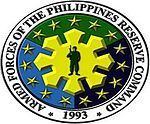Country Philippines | ||
 | ||
Active April 1, 1993 - Present Allegiance Republic of the Philippines Branch Technical & Administrative Service Branch Type Technical & Administrative Service Reserve Force Role Combat Support & Service Support, Force Multiplier, Training, Disaster Rescue & Relief, and Community Service | ||
Infomercial armed forces of the philippines reserve command
The Armed Forces of the Philippines Reserve Command, known officially as the AFP RESCOM or RESCOM, (Filipino: Pangasiwaan ng Panlaang Kawal ng Hukbong Sandatahang Lakas ng Pilipinas) is one the Armed Forces of the Philippines' Major Support Commands created for the sole purpose of Reserve Force management, procurement, and organization.
Contents
- Infomercial armed forces of the philippines reserve command
- Training
- Specialization Training
- Types of Reservists
- The Commissioned Officer Corps
- Lineage of Commanding Officers
- Base Units
- Civil Military Reserve Units
- Technical Service Reserve Units
- Affiliated Reserve Units
- Standby Reserve Units
- References
Training
Training is the major task handled by AFPRESCOM. Its primary modes of enlisting and commissioning reservists are the Reserve Officer Military Training (ROMOT); Military Orientation Training Course (MOTC) and the Basic Citizens Military Training (BCMT). Graduates are given enlisted ranks based on reciprocity of their civilian experience in the military environment.
Reserve officers are commissioned based on Armed Forces of the Philippines policy on (direct) commissionship in the reserve force known as Circular 30. Those who are commissioned through this source subsequently undergo an officer orientation program. Many officers in AFPRESCOM are licensed physicians, dentists, nurses, pharmacists, teachers, lawyers and chaplains. Some are directly commissioned as Lieutenant Colonels through the commissioning program of National Defense College of the Philippines as graduates of the Masters in National Security Administration.
Other than time-in-grade and merit promotions, rank adjustments are authorized depending on civilian qualifications.
Specialization Training
These are the trainings available for military reserves at AFPRESCOM:
Trainor: PA Special Forces
Trainor : 710th SPOW PAF
Trainor: AFPRESCOM SCUBA DIVER/PN
Trainor: PA CMOG School
Trainor: PA
Trainor: PA SEG in coordination with PNP CSG
Trainor: PA Scout Rangers
Trainor: PA
Trainor: PA Light Armour Division
Trainor: PAF
Types of Reservists
There are currently two (2) types of reservists in the component of the Armed Forces of the Philippines (AFP) Reserve Force:
The Commissioned Officer Corps
Most of the officers of AFPRESCOM are directly commissioned through AFP Circular Nr. 4 and 6 and may come from any of the following professions, :
Lineage of Commanding Officers
Commanding Officers of the AFPRESCOM are drawn from all Tri-Service Commands of the AFP.
